How to replace water supply risers in an apartment: a step-by-step guide
In old houses, failure of the water supply system is a common occurrence.And installing an internal pipeline from modern materials or purchasing new plumbing fixtures does not solve the problem.
Only a complete replacement of the water supply risers in the apartment helps. If you have already encountered a similar problem and don’t know where to start, we will help you figure it out. The article will discuss what requirements should be observed when replacing risers, what stages the installation involves connecting the system and what materials will be needed for this.
The content of the article:
Replacing the riser: legal aspect
A water riser is a vertical section of pipeline equipped with a shut-off valve at the base. It is common property.
Therefore, its replacement must be carried out by the management organization (housing department or housing office) without additional payment from the tenant or owner.
The apartment owner only needs to write an application addressed to the HOA manager, indicating the problem that needs to be solved. The only exception is if the house is not the property of the housing department. In this situation, repairs to common property are carried out at the expense of the residents.
Common property includes everything that is located on the site from the riser to the first shut-off valve. If a shut-off device is not provided up to the mixer itself, then this area inclusively belongs to the common property.
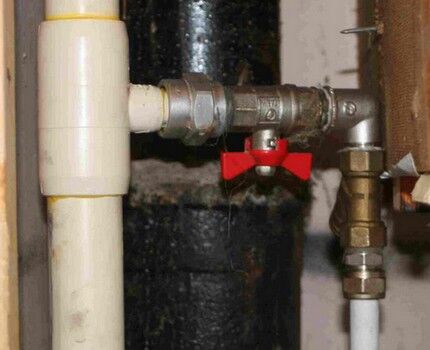
If the owner of the apartment plans to carry out major repairs and at the same time make hidden pipeline installation, or he decided, in connection with the redevelopment, to move the riser to a new location - all work will be carried out at his expense.
Any redevelopment related to the use of home property, including apartment risers, must be agreed upon with management organizations. Only by handing over the appropriate permission in writing can he invite installers from a management organization or private company to carry out the work.
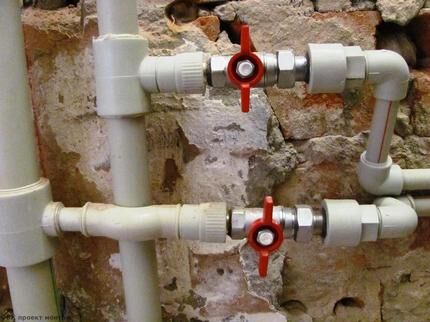
Reasons for installing a new riser
The need to replace a vertical pipeline arises in two cases: after the expiration date of the metal structure and when performing a complete renovation of the bathroom.
Depending on the conditions, its replacement is performed in one of two modes:
- planned – when water pipes are worn out;
- emergency – if a malfunction or leak occurs.
In old houses, the “original” apartment risers are made of galvanized or cast iron pipes. Metal structures are susceptible to corrosion and therefore require replacement.
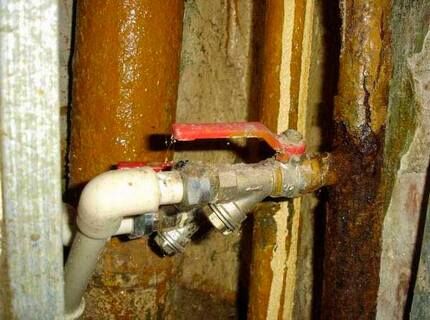
It has been noticed that pipes wear out the most in interfloor ceilings. Therefore, the joining of the new pipe to the old one should be done outside the ceiling: in the bathroom of neighbors living on the floor below or above.
For metal pipes, the service life is about a quarter of a century. In reality they last much longer. But after forty years of service they fall into disrepair.
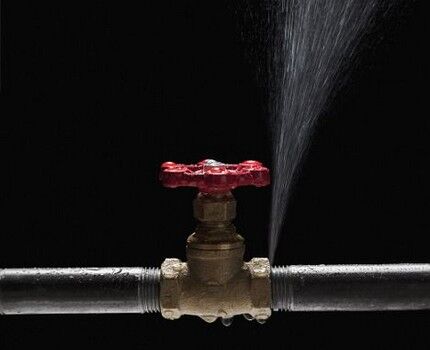
Even if the pipes look intact after the end of the operational period, it is still recommended to replace them. This is explained by the fact that a pipe worn out over time can burst at any time, which will lead to great material damage both for the owners of the apartment and for neighbors affected by flooding.
In scheduled mode pipe replacement It is recommended to carry out it at the stage of major repairs. When arranging modern interiors, it is customary to “hide” the pipeline in the wall, and therefore getting to it in the event of an emergency will not be easy.
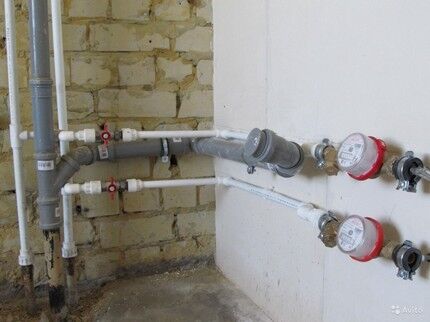
Cast iron pipes are usually replaced with polypropylene analogues. And this choice is fully justified by a number of undeniable advantages that the polymer has.
These include:
- resistance to corrosion and aggressive influences;
- smoothness of the inner walls, preventing the accumulation of limescale on the inner surface of the pipeline;
- high strength;
- environmental Safety.
For arranging a pipeline with cold water, ordinary metal-plastic and polypropylene pipes appropriate diameter, and for serving hot - pipes intended for heating systems. They are characterized by higher strength and increased resistance to deformation.
Manufacturers of polypropylene pipes claim that the service life of products is about 50 years, and those used to supply cold water are about 100 years.
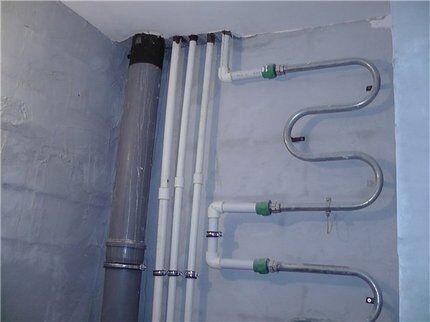
Compared to metal structures, installation of polypropylene pipes takes much less time. The use of welding technology makes it possible to obtain a strong and reliable connection with minimal effort.
Water supply riser replacement technology
Water supply risers are located in bathrooms, placing them at a slight distance from the wall. The riser must be equipped with a shut-off valve, which is used to shut off the water supply to the apartment.
Ideally, the entire span should be replaced. But in practice this does not always work out. As a last resort, the area from floor to ceiling should be replaced. In this case, it is unacceptable to update only a short section of pipe that has been rusted.
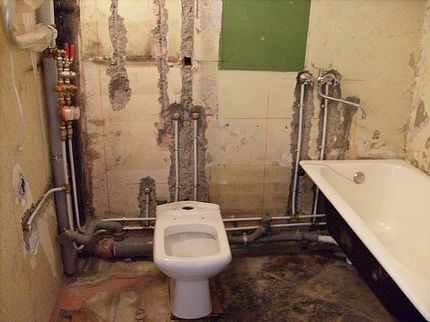
If the riser is being replaced in an apartment building, neighbors should be notified in advance about the time of repair work. You should agree with neighbors living in apartments located directly above and below yours about the possibility of carrying out work on their territory. After all, the new pipes will pass through the ceilings.
If consent cannot be obtained, the pipe connections will have to be made within your bathroom: above the floor and under the ceiling.At the same time, it is imperative to provide access to the places where the pipes will be joined, so that if a leak occurs, it can be quickly eliminated.
Stage #1 - selection of materials
Having settled all the issues with the neighbors and the management organization, you can begin to draw up a plan. Compiling it will allow you to determine the layout of the bathroom pipeline and calculate the amount of consumables.
To carry out the work you need to prepare:
- polypropylene pipes D110mm;
- fittings of the appropriate diameter;
- metal clamps;
- silicone sealant.
Pipes for installing a vertical pipeline should be selected with a diameter that is equal to the cross-sectional size of the dismantled elements.
To connect the sections of the riser to be replaced with neighboring ones, couplings and compensators D110mm are used. To connect a plastic pipe to a steel pipe transition cuffs are used.
At the same time, the finishing of the riser is thought through: the need for noise and heat insulation, the structure and design of the box.
Tools you will need:
- Bulgarian;
- 3-4 cutting discs D125mm;
- thread cutting tool;
- adjustable and gas wrench;
- building level;
- a simple pencil;
- Screwdriver Set;
- chisel;
- hammer;
- roulette;
- crowbar (for use as a lever).
It is necessary to prepare protective equipment in advance: a hat, a respirator, goggles and thermal protective gloves.
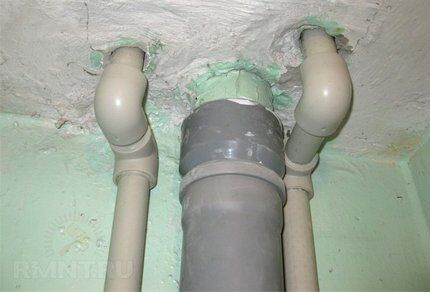
For welding polypropylene pipes You need to purchase or rent a soldering iron equipped with Teflon tips of different sizes.
Utility services schedule work to replace the riser on weekdays in the time interval from 10 a.m. to 3 p.m., when many residents are at work. This allows you to minimize the temporary inconvenience of limiting the operation of the system.
Disconnection of an existing pipeline is carried out with the involvement of specialists, but not independently. On average, repair work takes from 30 to 60 minutes. But in order not to miss important details, you shouldn’t rush too much.
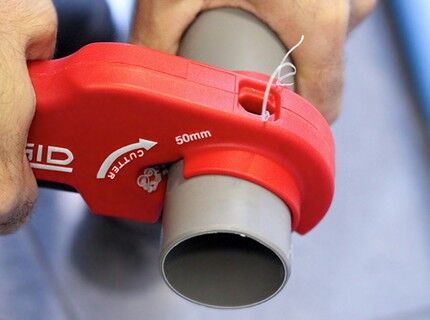
Stage #2 - dismantling old pipes
Dismantling a vertical pipeline made of water and gas steel pipe is one of the plumbing jobs of increased complexity.To perform them, you must have sufficient experience working with electric tools and strict adherence to safety precautions.
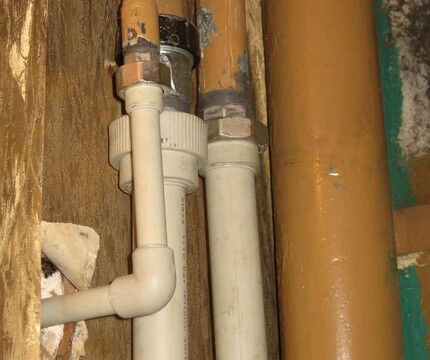
The first step is to shut off the system and drain the water from it. This work must be performed by a representative of the utility company. You should not break the rule - otherwise you will receive an administrative penalty.
Using a grinder or armed with a pipe cutter, cut out old pipes. To do this, two horizontal cuts are made at a distance of 10-15 cm, converging to the edge of the pipe located near the wall. To prevent the upper part of the pipe from sagging, it is better to not make the cuts completely at first.
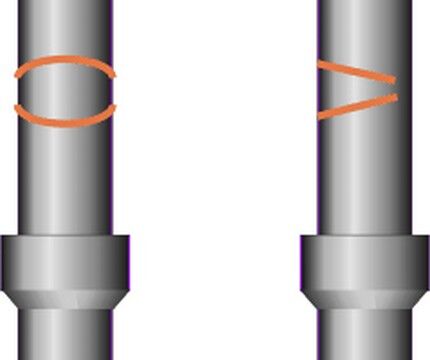
The upper piece of the pipe is cut to a calculated height equal to the length of the fitting that will be pressed during installation. The master’s task is to make the cut plane perpendicular to the axis of the pipe itself.
To make this task easier, use a strip of masking tape as a guide. It is glued around the circumference so that the end exactly overlaps the beginning.
To remove the lower section of the riser, carefully loosen the pipe, being careful not to damage the socket. The solution at the junction is hollowed out around the perimeter. The cut pieces of pipe are removed using a wedge or crowbar.
In former times, connections of cast iron pipes were made in one of two ways:
- by caulking seams with cement-sand mortar;
- by filling the joint with sulfur.
To remove hardened cement mortar, the top layer of the seam is picked out with a screwdriver.The easiest way to burn off sulfur is to heat the pipeline elements with a blowtorch. To regulate the draft in the riser, a metal or asbestos-cement shield is laid on top of the pipe. After heating the structure, disassembling the connections will not be difficult.
The cut elements are carefully pulled out of the floor slabs using a screwdriver, and the stuck pieces are knocked out with a hammer. On the cleaned area, places are marked for placing the clips necessary for fastening the pipes to the wall at the distribution points.
Stage #3 - installation of a new pipeline
Using a hacksaw or scissors for polypropylene cut new pipes into elements of the required length. Marks are made on the sections of elements to be connected indicating to what point the connection will be made.
If your neighbors still have metal risers, it is necessary to assess the condition of the metal structure, determining whether threading can be done at its end. To simplify the cutting procedure, the end of the pipe is lubricated with machine oil.
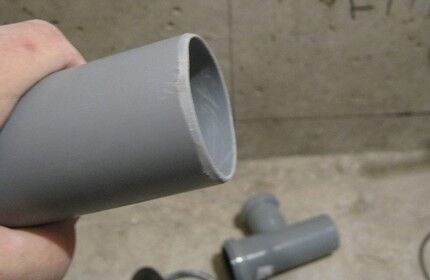
If a metal pipe does not inspire confidence and there is a suspicion that when a load is created when cutting a thread, it may burst, you should do it easier by welding a finished thread of 5-7 turns, or making a connection using a collet coupling.
It will now be possible to connect an adapter coupling with a thread for installing a plastic pipeline.
The metal is joined to the plastic by means of a threaded connection using a coupling. Tightening during installation should be done with slight reinforcement. To achieve this effect, the joints are sealed with linen winding and coated with investment paste.Before putting the adapter on a cast iron pipe, the connection points should be treated with sealant.
Connecting plastic elements is much easier. The adhesions are cleaned and treated with an alcohol composition.
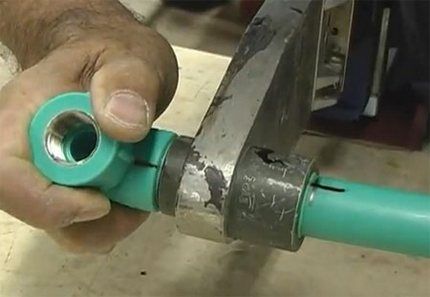
At the same time, both the fitting and the end of the pipe are put on the heated apparatus. Both elements are screwed to the entire depth of the nozzles. After waiting for the elements to warm up, both workpieces are carefully removed from the nozzle and connected to each other.
Features of connecting to the wiring
In the place where the vertical pipeline will connect to the wiring in the apartment, install a tee measuring 32/20/32. To facilitate installation of the tee, its end is lubricated with liquid soap. The elements are fixed by soldering.
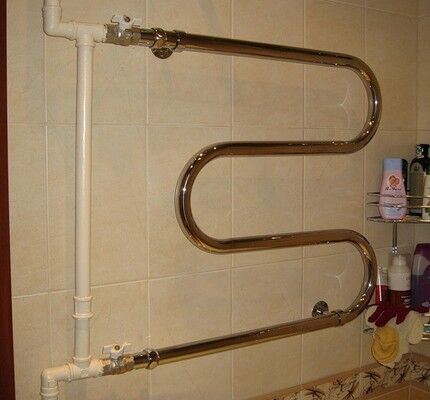
An important point: when installing tees, it is preferable not to use a coupling, but a soldered connection.
After installing the shut-off valve, check for leaks. If there is none, fix the assembled structure to the wall.
To do this, using a building level, pre-mark points in the wall for making holes for installing clips. Fastening elements are placed every 100-150 cm.
From the moment the last connection is made, the installed section of the network can be filled with water no earlier than an hour later. To ensure a sufficient level of moisture resistance and sound absorption, the places where pipes pass through the ceilings are concreted throughout the entire thickness. These and other finishing activities are carried out only after testing the structure.
Conclusions and useful video on the topic
Sequence of actions when replacing a steel pipeline with polypropylene:
How to overcook water supply risers:
There is nothing complicated about replacing an apartment water supply riser. The main thing is to obtain permission from the housing office and obtain the consent of the neighbors to carry out the tie-in. By following installation technology and using high-quality materials in your work, you can build a system on your own that will serve you well for decades.
If, while reading the information, you have questions or have experience in replacing water supply risers and you want to share it with our readers, please leave your comments in the block below.




If a person lives in a private house, then there is only one question regarding replacing risers - the entire system needs to be changed at once, in order to avoid accidents in other areas. There are several issues in apartments, ranging from the disagreement of neighbors to the fact that you will have to pay yourself. But you need to warn your neighbors in advance - if you change everything at your place, then sooner or later, due to the characteristics and service life of the riser, they will have an accident.
They changed my cast iron to polypropylene about three years ago, all at once. The risers were changed throughout the entire entrance, and they did all the wiring for me at the same time. This is a different quality of life! In general, everything stopped flowing! I can’t say anything about durability, but three years later they are no different from brand new. And all the valves were changed to brass, they also work great. In Soviet times, one could probably only dream about this.
Everything is true, but what does “Soviet times” have to do with it? At least you thought with your head before writing nonsense.Technologies have changed, installation has become easier, and the quality of life has improved.
They replaced the neighbors' riser on the third floor without warning anyone... they hammered through the entire pipe... all the scale and crap fell between the 1st floor and the second... They turned on the system, it poured into my sink, flooded everything and everyone... what kind of repair is this!? The result is a kitchen set down the drain, and who is responsible!?
Hello. The one who is responsible for the accident will be responsible and compensate for the damage. It is enough to conduct an independent examination. Although, theoretically, the Criminal Code should have drawn up an act of flooding, but if the fault is on them, then, of course, they did not “notice” it. Don’t be afraid, go to court, usually the injured party wins such cases.
The author apparently got it a little mixed up. The article first writes about replacing water pipe risers with polypropylene, and then in the middle of the article we are talking about PVC pipes for sewerage...
All repair work must be carried out in accordance with regulatory documents. And the neighbors have no right to object to this (housing code of the Russian Federation). Replacing risers is a common property. If there is an objection, there will be a trial, then it won’t seem like much. Replacing pipes from floor to ceiling, as the author of the article suggests, is simply unacceptable according to regulatory documents.
Hello. Indeed, they cannot object if 2/3 of the residents at a general building meeting agree with the decision to replace or repair. There are also articles on the basis of which the court will most likely rule in your favor:
«Part 3 of Article 17 of the Constitution of the Russian Federation. The owner can dispose of his property as he wants, but these actions must not violate the rights and interests of other citizens.In this case, the rights and interests of neighbors who want to change the riser for better living conditions are violated«.
«Clauses 10-12 of the Rules for the maintenance of common property in an apartment building. According to them, homeowners must monitor the repair of all communications and general equipment and restore them as necessary. Therefore, if your neighbors refuse to replace the risers, they are violating these rules and requirements, which are also confirmed by Articles 30, 39,156 of the Housing Code of the Russian Federation«.
BUT!
«Article 44, 46 of the RF Housing Code. Replacing a riser is a major overhaul, a decision on which must be made taking into account every vote of the owner of a part of an apartment building. If 2/3 of the votes of the total number of residents are collected in favor of the repair, then the decision is positive. If the same part is against replacing the risers, then negative«.
As for “from floor to ceiling”, please clarify what kind of regulatory documents these are.
Hello Amir!
They say: “It has been noticed that pipes wear out the most in interfloor ceilings. Therefore, the joining of the new pipe to the old one should be done outside the ceiling: in the bathroom of neighbors living on the floor below or above.”
What document defines this?
This remark is convenient for the owner who wants to make repairs at home without waiting for major repairs and plumbers performing this work. This is real money, additional income.
The management company also benefits. Saving money on major repairs.
This year, 9.44 per square meter is spent on major repairs. The total area of the owners is 14662.8 square meters. meters.
Owners pay per month: 9.44 x 14662.8 = 138416.83 rubles
For the year: 138416.83 x 12 = 1,661001.98 rubles
For the owner, the connection between the neighbors below and above is good; he will benefit.
The neighbor below had pieces of the ceiling broken out where the risers passed through the ceiling.
The neighbor upstairs has broken floor and wall tiles in the passage areas.
They made repairs.
Those. the interests of one owner against the interests of two owners.
The management company takes the side of one owner. It benefits her. He begins to intimidate with the “Act of Refusal...” so as not to overhaul the riser.
The condition of the riser is the same from the first to the last.
Good day.
The question is this: the neighbors above and below replaced the pipes on the cold water riser from steel to plastic, of course, no one changed the ceilings (leaving the “cons” of delayed action), no one came to us and offered to install a pipe for replacement/repair. This was done a long time ago, we still had a management company, now we have a homeowners association (I doubt that at the time of the replacement they had permission to replace it, i.e. they did it without permission).
If I (now the riser is old, not replaced, I would be glad to change it, but I don’t see the point in changing from floor to ceiling without replacing the ceilings) an emergency occurs and there will be a leak in the apartments below, or vice versa, it will leak from above (in the ceiling) and then down — who will be responsible? HOA, upper and lower tenants or me?
Hello. If neighbors who made an unauthorized replacement provoke an emergency leak, I will replace them all at their own expense, subject to proven guilt on their part.
If repairs have been agreed upon, the management organization is responsible for maintaining the common property in proper condition on the basis of paragraph 42 of Decree of the Government of the Russian Federation of August 13, 2006 N 491.
And an additional question: who should change the shut-off valve (faucet) on the cold water pipe in the basement, which should be used to shut off the water in the riser in the event of an emergency?
A request for a replacement has been written, but they do not change it. If during this time, God forbid, there is an emergency situation on the riser - the water cannot be turned off (it does not turn off completely, apparently it has worn out), the water will flow down. Whose fault will it be? When filing a complaint with regulatory organizations, which regulatory documents should be referred to?
I repeat. The management organization is responsible for maintaining common property in proper condition on the basis of paragraph 42 of Decree of the Government of the Russian Federation of August 13, 2006 N 491.
Good afternoon The riser was replaced 7 years ago using two 90-degree bends; recently the neighbor above began to complain about low water pressure in the evening. After an inspection by a representative of the management company, we were given a notice that the straightness of the riser had returned, and that this type of connection was the cause of a pressure drop of 1 MPa. Is this even possible?
Hello. They issued a notice in writing and responded to the neighbor's complaint in a radical manner - yes, you have gold, not a criminal code. Although the question is what they were thinking when they did the hydraulic calculations and why the neighbor was silent for 7 years.
Here we would like to look at the basis for the conclusion about the drop in pressure precisely because of the slope. Isn’t it due to blockages, poor water quality...
Tell me, if you replaced the hot and cold water pipes, but did not “seal” the remaining holes around the pipes, who is to blame for the water leaking below through these holes?
The one who is responsible for the work done ♂️
Good afternoon. The upstairs neighbors systematically flooded, the housing office shut off the water, and couldn’t find the reason. As soon as I asked to provide me with a leak report, they immediately found the reason that the pipes had rotted in the ceiling between our floors. According to the design of the house, the pipes are hidden in the wall. The following questions arise:
Who is restoring the walls and at whose expense and to what level? I just painted it white
Who is restoring the ceiling and at whose expense. I have a tension one and a part with gypsum cardboard
If the floor is damaged, who will restore the furniture and at whose expense?
How long does it take to restore everything?
Please tell me, in what standard and clause are the distances between the risers of hot water supply and hot water supply specified according to plumbing rules should be at least 10 cm??
Good afternoon, the management company has replaced the emergency HVL riser with a ferrous metal pipe. The 6th floor of a 9-storey building was galvanized. Can I demand replacement with galvanized one? Are there standards for materials?